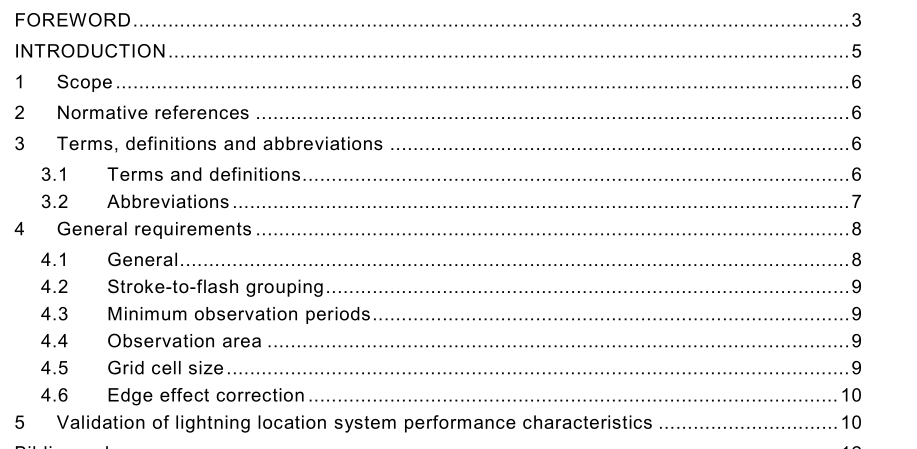IEC 62858-2015 pdf Lightning density based on lightning location systems (LLS) – General principles

5 Validation of lightning location system performance characteristics The performance characteristics of an LLS determine the quality of the lightning data available. These performance characteristics include: – detection efficiency for IC and CG flashes and CG strokes; – location accuracy; – peak current estimation accuracy; and – lightning classification accuracy. As stated in Clause 4, for N G and N SG determination of CG flash DE, LA, and lightning, classification accuracy is of primary importance. These performance characteristics can be evaluated using a variety of techniques which are summarized below. a) Network self-reference: In this technique, statistical analysis of parameters (e.g. [1 1 ]) such as standard deviation of sensor timing error, semi-major axis length of the 50 % confidence ellipse, and the number of reporting sensors, is used to infer the LA and DE of an LLS. Examples of such studies are found in [4] and [7]. This method requires data collected by the network after it has been properly calibrated. It can provide a good estimate of the network’s performance in a cost-effective, practical manner. b) Rocket-triggered lightning and tall object studies: This method uses data from rocket- triggered lightning experiments or lightning strikes to tall objects (e.g., instrumented towers) as ground-truth to evaluate the performance characteristics of an LLS within whose coverage area the triggered lightning facility or the tall object is located. The LA, DE, peak current estimation accuracy, and lightning classification accuracy of an LLS can be measured using this method. Examples of studies using rocket-triggered lightning for LLS performance evaluation include [6], [8], and [1 2], [1 3].
Video camera studies: Lightning data obtained using video cameras can be used as ground-truth to evaluate the performance characteristics of an LLS within whose coverage area the lightning discharges occur. The LA, DE and lightning classification accuracy of an LLS can generally be estimated using this method. Examples of studies using video camera for LLS performance evaluation include [1 ] and [1 4]. In this method, data collection can be time-consuming and challenging because the exact locations of lightning discharges to be captured on video cannot be predicted. Additional instrumentation such as antennas measuring electric field from lightning discharges is often required for this technique.
- ISO IEC 27050-4-2021 pdf Information technology — Electronic discovery — Part 4: Technical readiness
- ISO IEC 27036-1-2021 pdf Cybersecurity — Supplier relationships — Part 1: Overview and concepts
- ISO IEC 27013-2021 pdf Information security, cybersecurity and privacy protection — Guidance on the integrated implementation of ISO/IEC 27001 and ISO/IEC 20000-1
- ISO IEC 26580-2021 pdf Software and systems engineering — Methods and tools for the feature- based approach to software and systems product line engineering
- ISO IEC 24735-2021 pdf Information technology — Office equipment — Method for measuring digital copying productivity
- ISO IEC 24711-2021 pdf Information technology — Office equipment — Method for the determination of ink cartridge yield for colour inkjet printers and multi- function devices that contain printer components
- ISO IEC 23544-2021 pdf Information Technology — Data centres — Application Platform Energy Effectiveness (APEE)
- ISO IEC 23510-2021 pdf Information technology — 3D printing and scanning — Framework for an Additive Manufacturing Service Platform (AMSP)
- ISO IEC 23127-1-2021 pdf Information technology — Learning, education, and training — Metadata for facilitators of online learning — Part 1: Framework
- ISO IEC 23126-2021 pdf Information technology for learning, education and training — Ubiquitous learning resource organization and description framework
- IEC 61169-15-2021 pdf Radio-frequency connectors – Part 15: Sectional specification – RF coaxial connectors with inner diameter of outer conductor 4,13 mm (0,163 in) with threaded coupling – Characteristic impedance 50 Ω (type SMA)
- IEC 62826-2014 pdf Surface cleaning appliances – Floor treatment machines with or without traction drive, for commercial use – Methods of measuring the performance
- ISO IEC 17982-2021 pdf Information technology — Telecommunications and information exchange between systems — Close capacitive coupling communication physical layer (CCCC PHY)
- IEC 61472-2-2021 pdf Live working – Minimum approach distances – Part 2: Method of determination of the electrical component distance for AC systems from 1,0 kV to 72,5 kV
- ISO IEC 23127-1-2021 pdf Information technology — Learning, education, and training — Metadata for facilitators of online learning — Part 1: Framework
- BS ISO IEC 15420-2009 pdf Information technology一 Automatic identification and data capture techniques EAN/UPC bar code symbology specification
- BS ISO IEC 19762.5-2008 pdf Information technology一 Automatic identification and data capture (AIDC) techniques – Harmonized vocabulary Part 5: Locating systems
- BS IEC 60860-2014 pdf Radiation protection instrumentation一 Warning equipment for criticality accidents
- ISO IEC 24735-2021 pdf Information technology — Office equipment — Method for measuring digital copying productivity
- ISO IEC 24711-2021 pdf Information technology — Office equipment — Method for the determination of ink cartridge yield for colour inkjet printers and multi- function devices that contain printer components